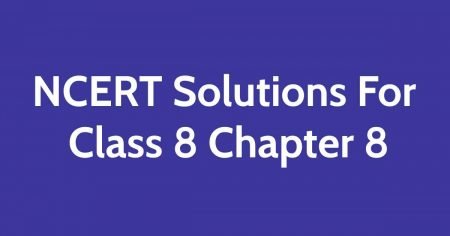NCERT Solutions For Class 10 Maths Chapter 8: The NCERT Solutions are created and evaluated by subject specialists to ensure that they address all of the questions in the textbook. These NCERT Solutions are based on the most recent revisions to the CBSE Syllabus for 2021-22 and its accompanying guidelines, as well as the first-term exam pattern.
Students will benefit from NCERT Solutions for Class 10 Maths Chapter 8 Introduction to Trigonometry since it will help them understand the concepts and perform well in the CBSE Class 10 first term examination.
NCERT Solutions For Class 10 Maths Chapter 8
NCERT Solutions for Class 10 Maths Chapter 1 Real Numbers
Actual Figures Class 10 comprises four exercises with a total of 18 problems. In earlier board exams, Prove Irrational, Problems based on Euclid’s division lemma, HCF and LCM, and Divisibility were frequently asked questions. The Fundamental Theorem of Arithmetic, important properties of positive integers, fraction to decimals, and decimals to a fraction are among the other topics covered.
NCERT Solutions for Class 10 Maths Chapter 2 Polynomials
Class 10 Polynomials features a total of four exercises with a total of 13 questions. Finding polynomials problems, properties zeros and coefficients, long division of polynomials, finding a quadratic polynomial, and finding polynomial zeros are all scoring themes.
NCERT Solutions for Class 10 Maths Chapter 3 Pair of Linear Equations in Two Variables
Class 10: Pair of Linear Equations has a total of seven exercises with a total of 55 problems. The questions will use topics such as two-variable linear equations, algebraic methods for solving linear equations, elimination method, cross-multiplication method, Time and Work, Age, Boat Stream, and equations reducible to a pair of linear equations. These solutions will make it easier for you to solve problems involving linear equations.
NCERT Solutions for Class 10 Maths Chapter 4 Quadratic Equations
Class 10 Quadratic Equations features a total of four exercises with a total of 24 problems. Finding the roots of quadratic equations and converting world problems into quadratic equations are two topics that score well in board exams.
NCERT Solutions for Class 10 Maths Chapter 5 Arithmetic Progressions
Class 10 Arithmetic Progressions features a total of four exercises with a total of 49 problems. The sum of n successive phrases and finding the nth term are significant subjects in this chapter 5.
NCERT Solutions for Class 10 Maths Chapter 6 Triangles
Class 10 Triangles features a total of six exercises with a total of 64 problems. The questions are based on triangle characteristics and nine key theorems that are critical for success in CBSE Class 10 exams.
NCERT Solutions for Class 10 Maths Chapter 7 Coordinate Geometry
Class 10 Coordinate Geometry features a total of four exercises with a total of 33 problems. Important models in class 10 boards include questions about determining the distance between two points using their coordinates, the Area of a Triangle, and the Line Divided in Ratio (Section Formula).
NCERT Solutions for Class 10 Maths Chapter 8 Introduction to Trigonometry
Class 10 of Introduction to Trigonometry has a total of four exercises with a total of 27 problems. The key subjects you will learn in this chapter are trigonometric ratios of specific angles, trigonometric identities, and trigonometric ratios of complementary angles. Trigonometry Formulas are critical in achieving a perfect score on board exams.
NCERT Solutions for Class 10 Maths Chapter 9 Some Applications of Trigonometry
One exercise in Trigonometry Applications Class 10 consists of 16 problems. In this chapter, you’ll learn about real-world applications of trigonometry, and the problems will be based on those applications.
NCERT Solutions for Class 10 Maths Chapter 10 Circles
There are 17 problems in total in Circle Class 10’s two exercises. Understand terms like tangent, secant, and number tangents from a point to a circle, as well as others.
NCERT Solutions for Class 10 Maths Chapter 11 Constructions
Class 10 comprises a total of four exercises with a total of 14 problems. Drawing tangents and drawing comparable triangles are major themes in the questions.
NCERT Solutions for Class 10 Maths Chapter 12 Areas Related to Circles
Circle-Related Subjects In class 10, there are three exercises totaling 35 problems. Solve problems using the ‘Perimeter and Area of a Circle,’ ‘Areas of Plane Figure Combinations,’ and ‘Areas of Sector and Segment of a Circle.’
NCERT Solutions for Class 10 Maths Chapter 13 Surface Areas and Volumes
Volumes and Surface Areas There are 36 problems in total in Class 10’s five exercises. The ‘Surface Areas and Volumes’ chapter is part of the mensuration subject in CBSE class 10 Maths. The issues revolve around determining the areas and volumes of various solids such as cubes, cuboid and cylinders, frustums, and solid combinations.
NCERT Solutions for Class 10 Maths Chapter 14 Statistics
There are a total of four exercises in Statistics Class 10 with a total of 25 problems. This chapter will look at how to find the mean, mode, and median of grouped data. Understanding the notion of cumulative frequency distribution will help you answer queries.
NCERT Solutions for Class 10 Maths Chapter 15 Probability
Class 10 comprises a total of two exercises with a total of 30 problems. This chapter will look at questions based on the concept of theoretical probability.
Trigonometric formulae explored in this chapter
Let’s consider the 3-points of a triangle that’s right-angled as OAB, where OA and OB make an angle of 90 degrees to every other.
Let,
OA be the adjacent side
OB be the opposite side
AB be the hypotenuse side
The hypotenuse side of any triangle is normally the longest side and the other 2 sides are shorter.
Therefore, from the provided information, the formula is gotten,
- sin = opposite/hypotenuse
- tan = opposite/adjacent
- cos = adjacent/hypotenuse
Class 10 Maths Chapter 8 chapter has exercises that are explained using a right-angle triangle. The practice problems can go with this containing the derivation of cosine, sine, tangent, & other trigonometric functions.
Another part covered in a chapter is measurements that are related to trigonometric-ratios & the other section is about subjects that are related to trigonometry identities
Topics & Sub Topics exercises in Class 10 Maths Chapter 8
In triangle ABC that’s right-angled at B, BC=7cm and AB=24cm. Find:
(a) sin A, cos A
(b) sin C, cos C
Explanation:
According to Pythagoras Theorem,
With a right-angled triangle, the hypotenuse side squared is equal to the sum of the squares of the other two sides.
That is
AC2=AB2+BC2
AC2 = (24)2+72
AC2 = (576+49)
AC2 = 625cm2
AC = √625
25
Thus, AC = 25cm
Getting Sin (A), Cos (A)
We understand that sine(Sin) function is equal to the ratio of the length of the opposite side to the hypotenuse side. Thus it becomes
Sin(A) = Opposite side divide with the Hypotenuse
BC/AC = 7/25
The cosine (Cos) function is the same as the ratio of the length of the adjacent side to the hypotenuse side.
Thus;
Cos(A) = Adjacent side/Hypotenuse
AB/AC = 24/25
Getting Sin(C), Cos(C)
Sin(C) = AB/AC
24/25
Cos(C) = BC/AC
7/25
Find tan P – cot R from the figure below
From the figure,
PQ=12cm
PQ=13cm
From right triangle
tanθ=opposite side/adjacent side
cotθ=adjacent side/opposite side
With Pythagoras theorem getting the measure of adjacent side/base.
(hypotenuse)2=(base)2+(perpendicular)2
(PR)2=(PQ)2+(QR)2
(13)2=(12)2+(QR)2
169=144+(QR)2
(QR)2=169−144
(QR)2=25cm2
QR=5cm
Thus;
tanP=opposite side/adjacent side
tanP=QR/PQ
tanP=5/12
cotR=adjacent side/opposite side
cotR=QR/PQ
cotR=5/12
tanP−cotR=5/12−5/12
tanP−cotR=0
If ∠A & ∠B are acute angles in that cos B = cos A, prove that ∠A = ∠B.
Explanation:
Considering triangle ABC is a right-angled triangle
∠A and ∠B are acute angles, in that
Cos(A) = cos(B)
Cos ratio is as
AD/AC = BD/BC
Interchanging the terms, we will have
AD/BD = AC/BC
Taking a constant value k
AD/BD = AC/BC = k
Let’s have the equation as
AD = k BD …. (1)
AC = k BC …. (2)
Using Pythagoras theorem in triangle CAD & triangle CBD we will have,
CD2 = BC2 – BD2 …. (3)
CD2 =AC2 −AD2 ….. (4)
From above equations (3) & (4) we will have,
AC2−AD2 = BC2−BD2
Substituting equations (1) & (2) in (3) & (4)
K2(BC2−BD2)=(BC2−BD2) k2=1
Placing this value in our equation, we get
AC = BC
∠A=∠B
Triangle ABC is right-angled (B), tan A=1/√3. Get the value of:
(a) sinA cosC + cosA sinC
(b) cosA cosC – sinA sinC
Explanations:
Let triangle ABC where ∠B=90°
tanA = BC/AB = 1/√3
Let BC = 1k & AB = √3 k,
k is positive real number
With Pythagoras theorem in triangle ABC we will have:
AC2=AB2+BC2
AC2=(√3 k)2+(k)2
AC2=3k2+k2
AC2=4k2
AC = 2k
Finding the values of cosA, SinA
SinA = BC/AC = 1/2
CosA = AB/AC
√3/2
Finding the values of cosC & sinC
SinC = AB/AC
√3/2
CosC = BC/AC
1/2
Substituting the values to the questions
(a) sin A cos C + cos A sin C
(1/2) ×(1/2 )+ √3/2 ×√3/2
1/4 + ¾
1
(b) cosA cosC – sinA sinC
(√3/2 )(1/2) – (1/2) (√3/2 )
0
- State if the following are false or true. Explain your answer.
(i) Value of tanA is all the time less than 1.
Answer
The statement is false. The value of tanA relies on the length of the right triangle sides which can be of any value.
(ii) Some value of angle A, sec A=12/5.
Answer
We understand that right triangle sec A = hypotenuse/adjacent side of ∠A
The hypotenuse of the right triangle is the biggest side.
Thus, the value of sec A needs to be bigger than 1.
From the given statement sec A = 12/5, which is bigger than 1.
Thus, the statement is true.
(iii) cos A is the acronym used for cosecant of angle-A.
Answer
The statement is false the reason being cos A is the acronym for cosine of angle-A. The abbreviation for cosecant of angle-A is cosecA.
(iv) cot A is a product of cot & A.
Answer
cotA is an abbreviation for cotangent of angle-A. Thus the statement is false.
(v) For angle θ, sinθ=43.
Answer
We understand that in a right triangle sinθ=opposite side/hypotenuse.
The hypotenuse is the longest side.
Thus, the value of sinθ needs to be less than 1.
From the statement given sinθ=43, is bigger than 1.
Hence, the statement is false.
- Show that:
tan48° tan23° tan42° tan67° = 1
Solution:
tan48° tan23° tan42° tan67°
We need to simplify the problem by converting some tan functions to cot functions
We understand that, tan 48° = tan (90°–42°) = cot 42°
tan 23° = tan (90°–67°) = cot 67°
tan (90°–42°) tan (90°–67°) tan 42° tan 67°
Substituting the values
cot 42° cot 67° tan 42° tan 67°
(cot 42° tan 42°) (cot 67° tan 67°)
1×1
FAQ
How can you understand the key ideas presented in the NCERT Solutions for Class 10 Maths?
BYJU’S recommends that students who want to achieve well in their Class 10 exams download the NCERT Solutions. A group of academics with extensive experience in the field curates the solutions with great care. Each and every minor element is discussed in an interactive manner to aid pupils in their learning. The step-by-step answers are created with the marks weighted according to CBSE criteria in mind.
Is it true that the NCERT Solutions for Class 10 Maths are good for CBSE students?
Some of the applications of the NCERT Maths Solutions for Class 10 are listed here.
1. It establishes a solid foundation of essential concepts and increases confidence in the ability to face term-based exams.
2. It is simple to learn how to solve complex problems.
3. It is an excellent study resource for students who want to complete their assignments on time and earn higher grades in their term exams.



